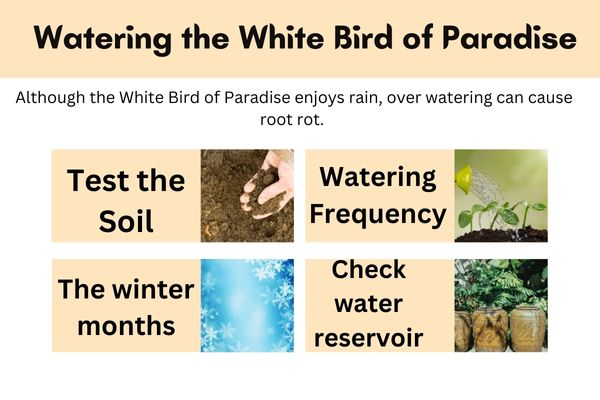The White Bird of Paradise (Strelitzia Nicolai) can become your next favorite addition if you’re a plant enthusiast. This plant, which is well-known for its broad, towering leaves and tropical vibe, adds a little something unusual to your living space. Despite being a tough plant, it requires particular care to flourish. You can assist your White Bird of Paradise plant care robust and healthy inside by following this guide, which will cover every facet of plant care.If you’re interested in expanding your indoor plant collection, you might also enjoy learning about How to Care for Angel Wing Begonia Plants, another striking choice with unique foliage and vibrant blooms.
- About the White Bird of Paradise Plant
- Key Aspects of White Bird of Paradise Indoor Plant Care
- Using the Soak and Dry Method
- Ideal Humidity for White Bird of Paradise Indoor Plant Care
- Best Temperature Range
- Fertilizing Your Giant White Bird of Paradise Plant
- Pruning Tips for White Bird of Paradise Plant Care
- Troubleshooting Common Issues in White Bird of Paradise Plant Care
- Final Thoughts
- Frequently Asked Questions about white bird of paradise plant care
About the White Bird of Paradise Plant

The White Bird of Paradise plant, which is indigenous to South Africa, is well-known for its enormous, banana-like leaves and magnificent height—it can grow up to eight feet indoors and even higher outdoors. The elegant form of its foliage is reflected in its name, which was inspired by birds in flight.
Often referred to as the Giant White Bird of Paradise plant, this plant gives houses a lush, tropical feel and can live for many years with the right care.
Key Aspects of White Bird of Paradise Indoor Plant Care

Light Requirements
Light is one of the most crucial elements in the maintenance of White Bird of Paradise plants. Although it can tolerate brilliant indirect light, this plant prefers bright direct light. But for the best growth:
• Direct Light: For optimal exposure, position it close to a window that faces south.
• Indirect Light: Windows that face east or west are also beneficial, particularly if your plant starts to exhibit symptoms of excessive sunlight.
Remember that this plant does not do well in low light conditions because it may curl its leaves or get dark patches.
Watering the White Bird of Paradise

Although the White Bird of Paradise enjoys rain, over watering can cause root rot. Here is a basic watering schedule to adhere to:
1. Test the Soil:
Stick your finger into the ground for about an inch. It’s time to water if the top inch is dry.
2. Watering Frequency:
Check soil moisture first, but generally every two to four weeks works well.
3. The winter months:
As the plant’s development slows down throughout the winter, water it less frequently.
Using the Soak and Dry Method
Utilize the soak and dry technique for efficient watering:
• First, water the soil until it is completely saturated.
• Step 2: To prevent soggy roots, make sure extra water flows out.
• Step 3: Water the soil once more after letting it dry up a little.
With this method, you can keep your plant watered without worrying about it rotting.
Ideal Humidity for White Bird of Paradise Indoor Plant Care
The White Bird of Paradise is a tropical plant that thrives in extreme humidity:
• Indoor Tips:
To naturally increase humidity, place a tray filled with water close to the plant, use a humidifier, or gather plants together.
• Low Humidity Symptoms:
It may be time to increase the moisture content if you notice browning edges on the leaves.
The ideal humidity range for your Birds of Paradise plant is 60% to 70%.
Best Temperature Range
This plant prefers a consistent indoor temperature:
• The ideal range is between 60°F and 80°F (16°C and 27°C).
• Steer clear of sudden temperature drops or drafts coming from windows, heaters, or air conditioner vents.
• Winter Care: To prevent stress on the plant, make sure the temperature doesn’t fall below 29°F (-2°C).
Fertilizing Your Giant White Bird of Paradise Plant

Fertilizer gives your plant the vital nutrition it needs to develop.
• From spring through summer, apply a balanced, water-soluble fertilizer every four to six weeks.
• Fall to Winter: Less fertilizer is needed because the plant will develop more slowly during the colder months.
To encourage lush, green leaves, look for fertilizers with a high nitrogen content; nevertheless, always follow the directions on the package to prevent overfertilizing.
Pruning Tips for White Bird of Paradise Plant Care
Pruning promotes new growth and keeps things looking neat. Here’s how to properly prune:
1. Remove Damaged or Yellowed Leaves: Trim any dried out or yellowed leaves with clean scissors.
2. Remove Congested Areas: This promotes even growth by letting light into the plant’s bottom sections.
3. Rotate the Pot: Every month, rotate the plant by around 90 degrees to guarantee consistent development.
Frequent trimming also aids in the early detection of illnesses or pests.
Troubleshooting Common Issues in White Bird of Paradise Plant Care

Sometimes problems occur even with the best treatment. Here’s how to recognize and address typical issues:
• Yellow Leaves:
Overwatering may be the cause of these. Before you water the soil again, let it dry.
• Brown Leaf Edges:
This is frequently caused by low humidity. Think about utilizing a humidifier.
• Wilting or Curled Leaves:
Low light levels may be the cause. Transfer your plant to a more light-filled area.
Pest Prevention
Although White Bird of Paradise plants are generally pest-resistant, in dry conditions they may attract pests like scale or spider mites. Use a moist towel to wipe leaves if you see any bugs.
• If need, apply a moderate insecticidal soap.
Final Thoughts
The White Bird of Paradise can turn any indoor area into a lush haven with its graceful, wide leaves and tropical elegance. You can support the White Bird of Paradise plant care by according to this guidance. You can enjoy this gorgeous plant for many years to come if you embrace its beauty and growth path.you can also learn how to care of Wandering Jew Plant?





